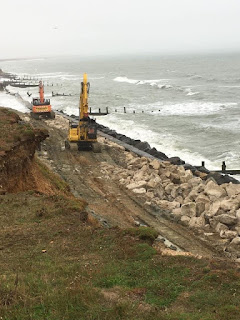Coastal properties in Milford on Sea are at "imminent risk" of damage this winter after the sea wall was smashed by two ferocious storms earlier this year, resulting in the failure of a 270 metre section of the concrete protection, which lies to the west of the Grade 2 listed White House.
The analysis by contractor Jacobs suggested stabilising the wall in the short-term and compensating for the loss of beach material which caused the failure.
Storm 'Ellen' hit on 20th August with high tides and 60 mph winds and sadly finished off the wall with the last beach hut standing succumbing to the sea. If we get another winter like the last one, goodness knows what the impact would be.
Last beach hut still standing but not for long. So wild - note the figures on the spit.
Beach hut down.
Sad evidence of the lost beach huts.
"Emergency work" is due to start.
The sea wall had been showing signs of "progressive failure" in November last year before a 95 metre section began to move in January. Storms 'Ciara' and 'Dennis' exacerbated that, and another 70 metre section in front of the beach huts fell away.
The failure of the seawall was down to loss of material at its base. Because the beach had lowered, the deeper water allowed larger, more powerful waves to strike. The wall had no "recovery time" between the storms and once its failure started "a continued and accelerated rate of dilapidation" occurred resulting in part of the wall "catastrophically" collapsing during Storm Dennis. The wall is believed to have been constructed around 60 years ago. Beach erosion was mitigated in front of new beach huts to the east by the installation of large rocks, which was not done at the affected site.
It is estimated the Milford cliffs would retreat at an average rate of 1.3 metres per year, leading to a loss of up to 16 metres by 2025, 50 metres by 2055 and 85 metres by 2105 but this is depends on how many large storms attack the cliffs.
Two very telling photos of the fence shutting the footpath on the cliff by the original collapsed Westover sea wall. First one taken 21st August at around 4 p.m. during the storms and the second at 2.30 p.m. on 22nd August as the storms continue. Compare the two photos - shows that the cliff has eroded 1 to 2 metres in under 24 hours. The second photo shows that the cliff has eroded some 4 metres since the fence was erected to the edge of the cliff a few weeks ago!
The coastal footpath was closed in February 2020 for safety reasons. The South Coast of England is a world heritage heavyweight with countless iconic landmarks - one being The Needles, beautiful sandstone cliffs on the lovely coastline of Alum Bay, Isle of Wight. They can be enjoyed from this wonderful coastal pathway where you get a marvellous view of The Needles and sweeping ocean views. So sad to have to leave this path and walk inland.
In a nature emergency, what really matters is action, not just words. New Forest District Council need to invest now and deal with the whole problem straight away. Ironic (or crazy!) that NFDC's current plan for defending the wall will leave the original breech (90 metres) and eroding cliff not repaired and unprotected for some 2 to 3 years! This will leave a weak spot which will concentrate the forces on a smaller area causing untold damage. The footpath is unlikely to reopen for a similar period!
This damage has been caused by years of neglect by the council. As Rachel Shattock wrote:-
For want of a good groyne the shingle beach was lost. For want of a shingle beach the sea wall was lost. For want of a wall the coast path and seafront was lost. For want of the frontline Milford-on-Sea will be lost. And all for the want of a good groyne. ("For Want of a Nail" is a proverb, having numerous variations over several centuries, reminding that seemingly unimportant acts or omissions can have grave and unforeseen consequences.)
It will be a matter of luck whether Milford on Sea will escape major flood damage this winter if the whole stretch is not repaired. The wind here is constant and the sea never sleeps. Erosion goes on all year round, sometimes unnoticed and sometimes dramatically when there is a big storm. For many weeks of the year, a potent mixture of high spring tides and south-westerly winds can prove fatal. When the weather is severe enough - as it was recently - to describe the coastline as being at the mercy of the sea is no exaggeration. The aging sea defences west of the White House have been turned to rubble in minutes. Metres of sandstone cliff, battered and weakened by the wind, is literally blown out to be scoured away in the boiling surf of an angry sea.
Times move on, and with sea defence, time is not on our side. Coastal defences should be at the forefront of NFDC's action files to build public confidence for the winter. The government is promoting a number of schemes at the moment - I urge the NFDC to take advantage of them and rebuild the flood defences completely.
The coastal defence team are ready to start very soon. Tonnes of rocks arriving from Norway and battle commences, man against the sea!!































No comments:
Post a Comment